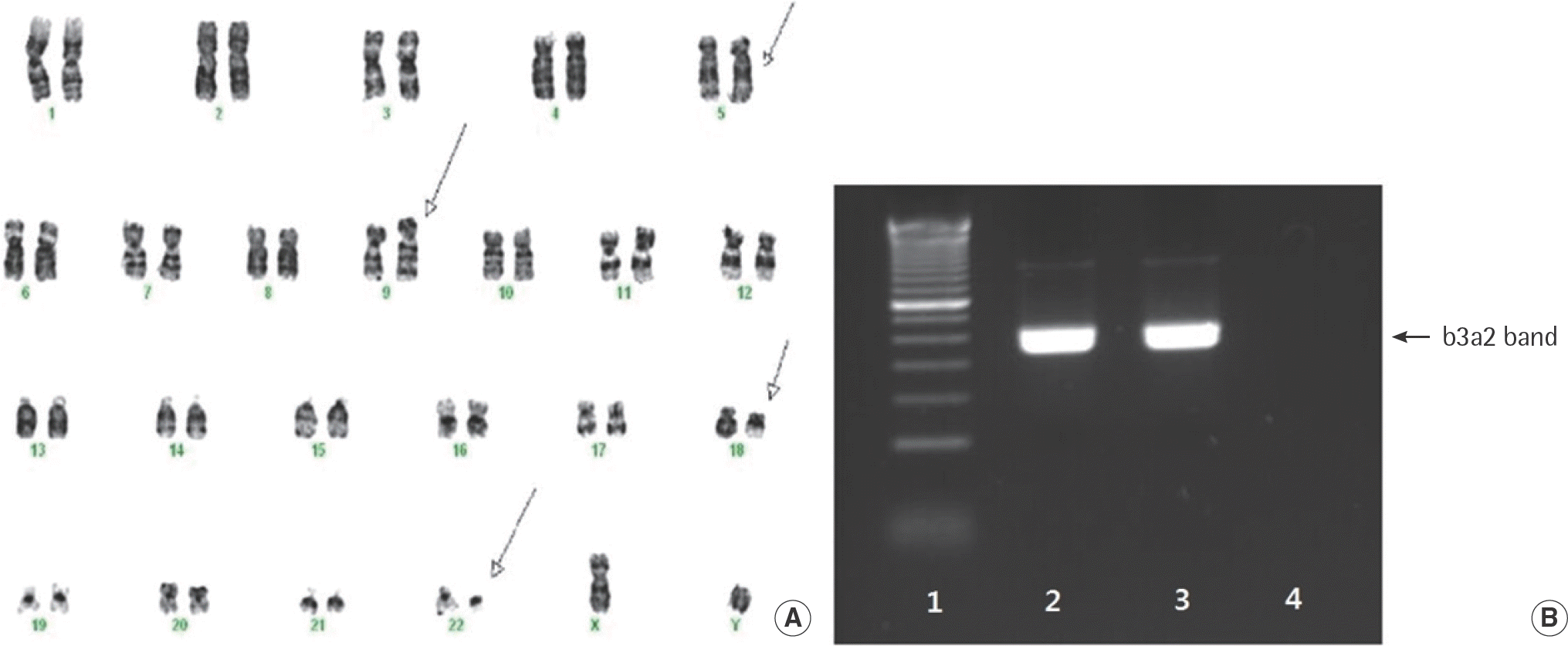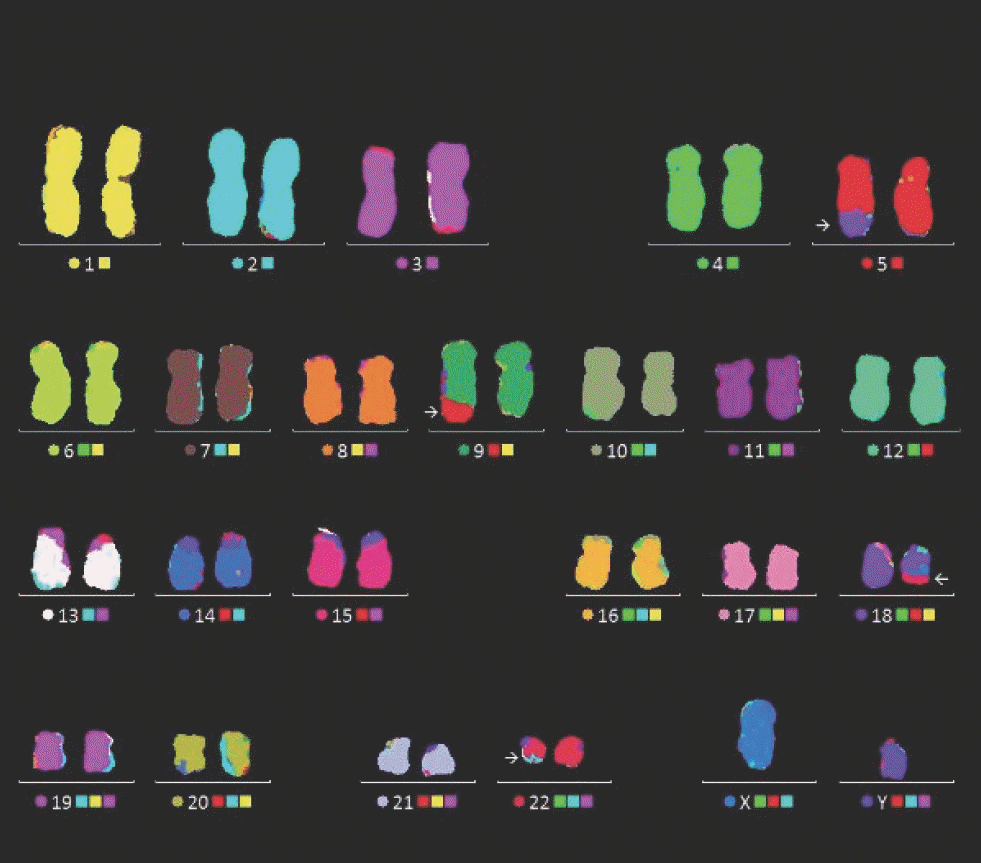Abstract
Chronic myelogenous leukemia (CML) is characterized by the presence of the Philadelphia chromosome, which is generated by a reciprocal t(9;22) (q34;q11) translocation. Variant Philadelphia chromosomes, found in 5–10% of CML cases, are a result of translocations involving other chromosomes, in addition to 9 and 22. These four-way Philadelphia chromosome translocations are very rare; only about 60 patients with such chromosomes have been described. Here, we report a CML case with a novel four-way variant Philadelphia chromosome. A conventional chromosome analysis of bone marrow cells revealed a 46, XY, t(5;9;22;18)(q31;q34;q11.2;q21) karyotype, which was confirmed by multicolor fluorescence in situ hybridization. The major BCR-ABL1 fusion gene was detected by reverse transcription-nested PCR. The patient was treated with imatinib. Twelve months after treatment, he demonstrated a complete hematologic response and chromosome analysis showed that he had a normal karyotype.
Go to : 
References
1. Rowley JD. Letter: a new consistent chromosomal abnormality in chronic myelogenous leukaemia identified by quinacrine fluorescence and Giemsa staining. Nature. 1973; 243:290–3.
2. Quintas-Cardama A and Cortes J. Molecular biology of bcr-abl1-positive chronic myeloid leukemia. Blood. 2009; 113:1619–30.
3. Marzocchi G, Castagnetti F, Luatti S, Baldazzi C, Stacchini M, Gugliotta G, et al. Variant Philadelphia translocations: molecular-cytogenetic characterization and prognostic influence on frontline imatinib therapy, a GIMEMA Working Party on CML analysis. Blood. 2011; 117:6793–800.

4. Al-Achkar W, Aljapawe A, Almedani S, Liehr T, Wafa A. A novel cytogenetic abnormality t(7;8)(p11.2: q11. 2) and a four-way Philadelphia translocation in an imatinib mesylate-resistant chronic myeloid leukemia patient. Oncol Lett. 2013; 5:617–20.
5. Reid AG, Huntly BJ, Grace C, Green AR, Nacheva EP. Survival implications of molecular heterogeneity in variant Philadelphia-positive chronic myeloid leukaemia. Br J Haematol. 2003; 121:419–27.

6. Al Achkar W, Wafa A, Mkrtchyan H, Moassass F, Liehr T. Novel complex translocation involving 5 different chromosomes in a chronic myeloid leukemia with Philadelphia chromosome: a case report. Mol Cytogenet. 2009; 2:21.

7. El-Zimaity MM, Kantarjian H, Talpaz M, O'Brien S, Giles F, Garcia-Manero G, et al. Results of imatinib mesylate therapy in chronic myelogenous leukaemia with variant Philadelphia chromosome. Br J Haematol. 2004; 125:187–95.

8. Adriana Z and Al Bahar S. Novel four-way Ph translocation t(9;22;7;1) (q34;q11;q22;p13) in a chronic myeloid leukemia patient receiving tyrosine kinase inhibitor therapy. Int J Hematol. 2012; 95:315–9.
9. Mitelman F, Johansson B, Mertens F (Eds.). Mitelman Database of Chromosome Aberrations and Gene Fusions in Cancer (2013). http://cgap.nci.nih.gov/Chromosomes/Mitelman. (Updated on Aug 2014).
10. Okada M, Satake A, Kaida K, Taniguchi K, Yoshihara S, Ikegame K, et al. Successful treatment with nilotinib after imatinib failure in a CML patient with a four-way Ph chromosome translocation and point mutations in BCR/ABL gene. Int J Hematol. 2011; 93:243–6.

11. Johansson B, Fioretos T, Mitelman F. Cytogenetic and molecular genetic evolution of chronic myeloid leukemia. Acta Haematol. 2002; 107:76–94.

12. Huntly BJ, Reid AG, Bench AJ, Campbell LJ, Telford N, Shepherd P, et al. Deletions of the derivative chromosome 9 occur at the time of the Philadelphia translocation and provide a powerful and independent prognostic indicator in chronic myeloid leukemia. Blood. 2001; 98:1732–8.

13. Sinclair PB, Nacheva EP, Leversha M, Telford N, Chang J, Reid A, et al. Large deletions at the t(9;22) breakpoint are common and may identify a poor-prognosis subgroup of patients with chronic myeloid leukemia. Blood. 2000; 95:738–43.

14. Cortes JE, Talpaz M, Giles F, O'Brien S, Rios MB, Shan J, et al. Prognostic significance of cytogenetic clonal evolution in patients with chronic myelogenous leukemia on imatinib mesylate therapy. Blood. 2003; 101:3794–800.

15. Richebourg S, Eclache V, Perot C, Portnoi MF, Van den Akker J, Terre C, et al. Mechanisms of genesis of variant translocation in chronic myeloid leukemia are not correlated with ABL1 or BCR deletion status or response to imatinib therapy. Cancer Genet Cytogenet. 2008; 182:95–102.

16. Yin CC, Medeiros LJ, Glassman AB, Lin P. t(8;21)(q22;q22) in blast phase of chronic myelogenous leukemia. Am J Clin Pathol. 2004; 121:836–42.

17. Pienkowska-Grela B, Rygier J, Woroniecka R, Grygalewicz B, Pastwin-ska A, Krawczyk P, et al. Karyotype changes during longterm targeted therapy of chronic myeloid leukemia with imatinib. Leuk Lymphoma. 2009; 50:952–65.
18. Kubota Y and Waki M. Chronic myeloid leukemia with a novel four-way t(6;13;9;22)(p21;q32;q34;q11.2) successfully treated with imatinib mesylate. Cancer Genet Cytogenet. 2010; 201:135–6.
Go to : 
 | Fig. 1.(A) G-banded karyotype of bone marrow cells demonstrating the t(5;9;22;18)(q31;q34;q11.2;q21) translocation. Arrows indicate rearranged chromosomes. (B) Gel electrophoresis of the reverse transcriptase-nested PCR products. It demonstrated the BCR-ABL1 gene rearrangement. Lane 1, molecular weight marker; Lane 2, a 443-bp band corresponding to the b3a2 rearrangement from the patient; Lane 3, positive control (b3a2, 443 bp); Lane 4, negative control. |
 | Fig. 2.Karyotype of a bone marrow cell using multicolor fluorescence in situ hybridization. A four-way translocation involving chromosomes 5, 9, 18, and 22 was identified. Arrows indicate the four rearranged chromosomes. |
Table 1.
Patient characteristics and responses to imatinib of 15 chronic myelogenous leukemia patients with a 4-way translocation
Cytogenetic response (based on the conventional chromosome analysis, % Ph-positive cells): CCyR=0%, PCyR=1–35%, MiCyR >35%. Abbreviations: CML, chronic myelogenous leukemia; F, female; M, male; CP, chronic phase; CCyR, complete cytogenetic response; PCyR, partial cytogenetic response; MicyR, minor cytogenetic response; NR, no response; NA, not available.




 PDF
PDF ePub
ePub Citation
Citation Print
Print


 XML Download
XML Download